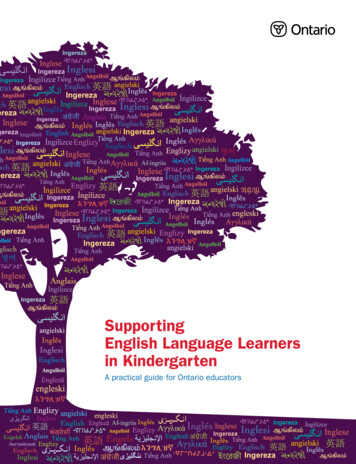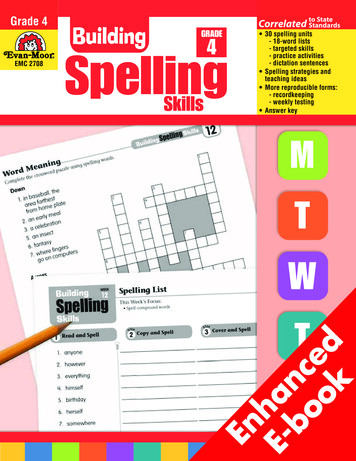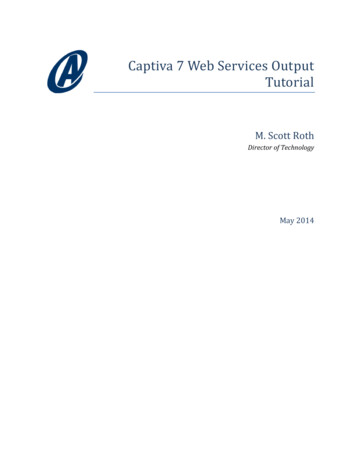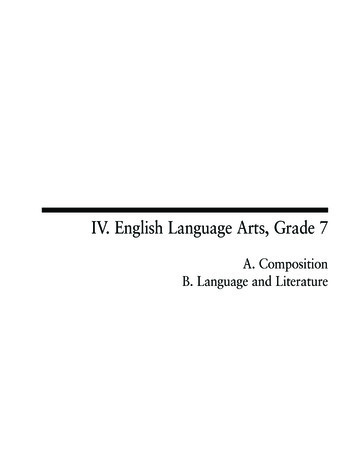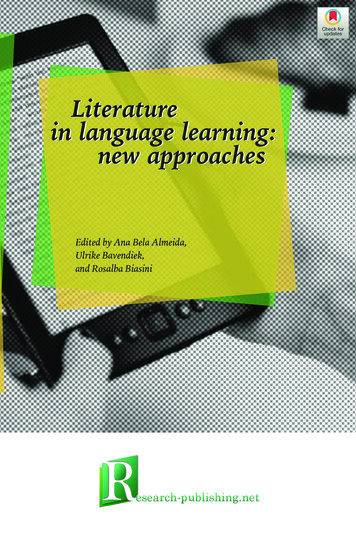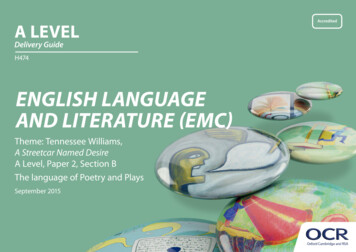
Transcription
A LEVELDelivery GuideH474ENGLISH LANGUAGEAND LITERATURE (EMC)Theme: Tennessee Williams,A Streetcar Named DesireA Level, Paper 2, Section BThe language of Poetry and PlaysSeptember 2015
We will inform centres about any changes to the specification. We will alsopublish changes on our website. The latest version of our specification willalways be the one on our website (www.ocr.org.uk) and this may differ fromprinted versions.Copyright 2015 OCR. All rights reserved.CopyrightOCR retains the copyright on all its publications, including the specifications.However, registered centres for OCR are permitted to copy material from thisspecification booklet for their own internal use.Oxford Cambridge and RSA Examinations is a Company Limited by Guarantee.Registered in England. Registered company number 3484466.Registered office: 1 Hills RoadCambridgeCB1 2EUOCR is an exempt charity.
A LEVELENGLISH LANGUAGE AND LITERATURECONTENTSIntroduction Page 4Curriculum Content Page 5Thinking Conceptually Page 7Thinking Contextually Page 9Learner Resources Page 21Teacher Resource Page 283
IntroductionKEYDelivery guides are designed to represent a body ofknowledge about teaching a particular topic and contain: Content: A clear outline of the content covered by thedelivery guide;Thinking Conceptually: expert guidance on the keyconcepts involved, common difficulties students mayhave, approaches to teaching that can help studentsunderstand these concepts and how this topic linksconceptually to other areas of the subject;Thinking Contextually: A range of suggested teachingactivities using a variety of themes so that differentactivities can be selected that best suit particular classes,learning styles or teaching approaches.Click to view associated resourceswithin this document.Click to view external resourcesIf you have any feedback on this Delivery Guide orsuggestions for other resources you would like OCR todevelop, please email resources.feedback@ocr.org.uk.4
Curriculum ContentComponent 02 is entitled The Language of Poetry and Plays. It is assessed by a closed text, two hour written examinationwhich represents 32% of the qualification. The first section deals with poetry, the second with drama. Students divide theirtime equally between the two sections.The drama question asks students to analyse the use and impact of dramatic and stylistic techniques, demonstrating howmeaning and effects are created in the play they have studied. They are given a short extract from the play which is printedin the exam paper. Students must draw on their knowledge of dramatic and stylistic techniques to show knowledge andunderstanding of the ways in which the playwright presents a theme, idea, character or other aspect of the drama in theextract.Students are expected to: Show knowledge and understanding of the play they have studied.Use linguistic and stylistic approaches and an understanding of dramatic techniques to develop an analysis of the text.Apply relevant methods for text analysis, drawing on linguistic and literary approaches.Explore contexts and connections between the scene and the play as a whole, as well as literary and generic contexts.Tackling the question will involve: Exploration of dramatic effect, most significantly the structure of dramatic dialogue but also on-stage and off-stageaction, paralinguistic features (gesture, manner of speech, facial expression), soliloquy, asides, dramatic irony.Analysis of the structure of the play (opening and closure, use of repetition, pattern making and breaking, parallel andcontrasting characters and action, cause and effect narrative vs episodic structure).Identification and description of the ways in which meanings and effects are conveyed through language; very probablydrawing on students’ knowledge of linguistic, literary and stylistic approaches but also adding or developing material onspoken language.Consideration of the significance of relevant dramatic or other contexts.5
Curriculum ContentTeaching A Streetcar Named DesireOne of Streetcar’s great advantages as a text to teach is its episodic structure – the eleven scenes are roughly the same lengthand each can be taught in a standard lesson. It might take two lessons to set things up and cover some context and the firstscene; another ten or so to explore the rest of the play; and then three or four more to do some round-up activities. Overall,teachers might spend about 21–25 teaching hours on the play.The 1951 film version of the play starring Marlon Brando and Vivien Leigh is easily available and a must for teaching. It stickspretty closely to the text and is a fascinating reading of it. There are a couple of variations (notably at the end) which wouldprovoke interesting discussion.6
Thinking ConceptuallyIt is likely that the drama text will be one of the lastcomponents of the A Level course to be studied so studentswill come to A Streetcar Named Desire with a confident workingknowledge of the analysis of lexico-grammatical features,semantics and pragmatics, denotation and connotation,discourse and genre from their study of the non-fictionanthology, the poetry and the novel. They will also be awarefrom the transcripts in the non-fiction anthology of some ofthe features of spoken language and its differences from thewritten. However, it may be a good idea to begin their studyof A Streetcar Named Desire with an activity that contrasts thedifferences between spoken language and dramatic dialogue.Short argues that dramatic dialogue is like conversationbecause: Both feature turn-takingSpeech acts in both are context dependentWe use schemas to make sense of conversations indrama and real lifeDramatic characters often say one thing and meananother and this is true of life as well.Short argues that dramatic dialogue is not like conversationbecause: Teaching could start with this observation from Mick Short: “If dramatic dialogue is both like and unlike ordinaryconversation, it is important for us to see where the similaritiesand dissimilarities lie. We can only apply conversationalanalysis to drama in relation to those areas where conversationand plays are similar.” Mick Short, Exploring the Language ofPoems, Plays and Prose (London: Longman, 1995, p.174). Get the group to discuss in pairs what they think thesimilarities and differences may be. Give as a stimulus a shorttranscript and a different example of dramatic dialogue toeach pairing (e.g. extracts from Shakespeare, EastEnders,Murder in the Cathedral, The Importance of Being Earnest, TheCaretaker, Top Girls all work well). Students may come up withsome of the following things which Mick Short identifies inchapter 6 of Exploring the Language of Poems, Plays and Prose(indispensable reading for material of this kind). 7Dramatic dialogue is written to be spoken whereascasual conversation is unprepared and unrehearsed.Drama has a ‘double-discourse’ structure: the overarchinglevel of discourse is that between the playwright and theaudience. Talk between characters is embedded in thathigher discourse, allowing the audience to ‘listen in’ towhat the characters say.Non-fluency features do not occur in dramatic orfictional dialogue (even though it is written to bespoken). If features from normal non-fluency do occurthey are perceived by readers and audience as having ameaningful function precisely because they know thatthe dramatist must have included them on purpose.In well-constructed dramatic dialogue everything ismeant by the playwright, even when it is apparentlyunintended by the character. The more realistic thedialogue, the more it should seem to be ‘unaimed’:unrelated to some obvious strategic or thematicpurpose of the author’s design.
Thinking Conceptually Back-channel behaviour does not occur as frequently inscripted speech as it does in real life.Once the first few scenes of A Streetcar Named Desire havebeen covered, returning to Short’s scale of realism may be aninteresting activity as different scenes offer different degreesof conversational realism.Short proposes a scale of realism for dramatic texts andsuggests consideration of the following questions whendiscussing how realistic a text is:It is also a good idea to get students thinking about the waysin which studying a drama text is different to studying prosefiction and poetry. There is an excellent activity exploring thisin the English and Media Centre’s book to accompany thiscourse.1) Is the lexis formal or informal?2) How complex is the grammatical structure of sentences?Is the dominant syntactic pattern for complex sentencesanticipatory or trailing?3) To what extent are there graphological contractions(e.g. I’ll, you’d)?4) What features associated with normal non-fluency arepresent? How are they to be interpreted in context?8
Thinking ContextuallyI: Genre – A Streetcar Named Desire and tragedyThinking about Streetcar as a tragedy is a very useful way into the play. Although it’s important to steer students away from anunthinking checklist approach to tragedy, the play lends itself to analysis from both traditional Aristotelian and more political,materialist perspectives.Teachers could use this model, drawn from Aristotle’s Poetics, as a starting point but one that students should be encouraged tointerrogate.Characteristics of a tragedy: A tragic hero – a term treated with suspicion by some critics who prefer the more neutral ‘protagonist’.The protagonist is basically good.The protagonist is usually high-born or someone of significance in society (‘one who is highly renowned and prosperous’,says Aristotle) so that their actions have consequences for the community and not simply for themself.A plot built around a downturn in the protagonist’s fortunes often triggered by a tragic flaw or error of judgement on theprotagonist’s part.A progression from order to disorder, harmony to chaos.The action of a tragedy seems to unfold with a horrible inevitability.Unhappy endings – the tragic catastrophe.An antagonist, a figure who stands out against the protagonist.The protagonist often has some moment of self-knowledge near the end of the play.The audience feel sorrow and pity at the end of a tragedy but leave the theatre morally enlightened and ennobled by theirvicarious experience of tragic suffering.This very simplified model begs some important questions:Is it necessary to be rich and powerful in order to be a tragic protagonist? As Williams’ great contemporary Arthur Millerputs it, ‘It matters not at all whether a modern play concerns itself with a grocer or a president if the intensity of the hero’scommitment to his course is less than the maximum possible.’ (‘Introduction’ to Plays I, London: Methuen, 1988, p.33)Is the catastrophe inevitable? Could matters have been different? Raymond Williams writes, ‘We have to see not only thatsuffering is avoidable, but that it is not avoided. And not only that suffering breaks us but that it need not break us.’ (ModernTragedy [1960] Stanford: Stanford UP, 1966, pp.202–3)9
Thinking ContextuallyIs the tragedy the result of individual failing (the tragic flaw) or a mistake, or might wider social forces and conflictsbe to blame? Adrian Poole argues that tragic playwrights ‘stage the points of convergence at which light and darkness meet,the sacred and secular, divine power and human reason. The ages that produced their drama were not characterized by stablecoherent belief. It was precisely the conflicts to which they gave expression, between old religion and new politics, betweentraditional faith and modern rationalism, between the sacred and the secular.’ (Tragedy: A Very Short Introduction, Oxford: OUP,2005, p.29)Does the protagonist have to be morally good? Aristotle himself is ambivalent on this: ‘It follows plainly, in the first place,that the change of fortune presented must not be the spectacle of a virtuous man brought from prosperity to adversity: for thismoves neither pity nor fear; it merely shocks us. Nor, again, that of a bad man passing from adversity to prosperity: for nothingcan be more alien to the spirit of Tragedy; it possesses no single tragic quality; it neither satisfies the moral sense nor calls forthpity or fear.’Do we feel better/enlightened/uplifted after watching a tragedy? Terry Eagleton takes issue with the idea that, as he puts it,‘tragic suffering is ennobling rather than appalling’: ‘In this perverse vision, real-life calamities – an air crash, a famine, an outbreakof genocide – do not count as tragic, since they leave us despondent rather than delighted. Aeschylus is tragic, but Auschwitzis not. [ ] Besides, in this view tragedy is a thoroughly virile affair, a matter of heroes, warriors and a very masculine nobilityof spirit. It does not chime with the sensibility of a secular, sceptical, democratic age.’ (Foreword to third edition of JonathanDollimore’s Radical Tragedy, Basingstoke: Palgrave, 2004, p.x)Does tragedy ever give us hope for the future or does it portray life as meaningless and chaotic? ‘Some critics find theexperience of watching the end of a tragedy to be a gloomy confirmation of human powerlessness,’ writes Sean McEvoy, ‘otherssee there a pointer to a more just world which is perhaps the product of, but separate from the conflicting forces which havejust destroyed the protagonist. There is death, waste and destruction at the end of a tragedy, but there is always some hope.’(Shakespeare: The Basics, London: Routledge, 2000, p.185)Two other viewpoints relevant to Streetcar:‘Tragedy always deals with toxic matter bequeathed by the past to the present. In personal terms, this often means what fathersand mothers have passed on to their children in the form of duties, loyalties, passions and injuries.’Adrian Poole, Tragedy: A Very Short Introduction (Oxford: OUP, 2005, p.35)‘Tragedy is the art form created to confront the most difficult experiences we face: death, loss, injustice, thwarted passion,despair.’Jennifer Wallace, The Cambridge Introduction to Tragedy (Cambridge: CUP, 2007, p.1)10
Thinking ContextuallyII: A Streetcar Named Desire and ideas of the American South‘I write out of love for the South,’ wrote Williams, ‘But I can’t expect Southerners to realise that my writing about them is anexpression of love. It is out of regret for a South that no longer exists that I write of the forces that destroyed it.’ (quoted by hismother in Edwina Dakin Williams and Lucy Freeman, Remember Me to Tom (New York: Putnam, 1963).Ideas of the South are very important to Streetcar; here are some things the students should know:The prosperous economy of the southern states, founded on cotton plantations worked by Negro slaves, was ruined after defeatin the American Civil War (1861–65) which killed millions and almost broke a nation, leaving deep scars and the guilt and traumaof slavery. The South’s recovery was further held back by inadequate educational provision, poverty, racial conflict and what RodHorton and Herbert Edwards call ‘a paralyzing obsession with the largely imaginary glories of the past’.The southern states have a very distinct regional identity. Southerners are supposed to have a particularly romantictemperament; according to this archetype, their key characteristics include: IndividualismSensitivity to criticismA highly developed code of personal honourPride in race and the familyA chivalric attitude to womenFormal patterns of behaviourA fondness for rhetoricA lack of intellectual statureA romantic and nostalgic conservatism.A character in William Faulkner’s Absalom, Absalom (1936) tells a Northerner, ‘You cant [sic] understand the South. You wouldhave to be born there.’ It would be helpful, perhaps after the play has been taught, to see how many of these bullet pointsinform the play and especially Williams’ characterisation of Blanche.[References: Malcolm Bradbury (ed.), The Atlas of Literature (London and New York: De Agostini, 1996, pp.122–126); Rod W. Hortonand Herbert W. Edwards, Backgrounds of American Literary Thought, third edition (Englewood Cliffs NJ: Prentice-Hall, 1974, p.374)]11
Thinking ContextuallyIII: Production background A Streetcar Named Desire was first produced in America on Broadway in 1947, directed by Elia Kazan, and in Great Britain in1949 in a production directed by Laurence Olivier. The Broadway production ran for two years and 855 performances and won Williams the New York Drama Critics’ Circle BestPlay award and the Pulitzer Prize for drama in 1948. Streetcar, according to Thomas Powers, ‘was the play that set Williams apart for life. Few lines outside of Shakespeare are aswidely recognised as Blanche’s final words – “I have always depended on the kindness of strangers.” Blanche and Stanley areamong the great characters of American literature.’ Other key plays by Williams include The Glass Menagerie (1944), Cat on a Hot Tin Roof (1955), Sweet Bird of Youth (1959) andNight of the Iguana (1961). Other key American plays of this period include: Arthur Miller’s All My Sons (1947) and Death of a Salesman (1949), andEugene O’Neill’s The Iceman Cometh (1946). A Streetcar Named Desire has been filmed twice: the 1951 adaptation was directed by Elia Kazan and starred Marlon Brando,Vivien Leigh, Kim Hunter and Karl Malden. A further version made for American television was screened in 1984 and starredAnn-Margret and Treat Williams. The play has been frequently revived since with Glenn Close, Jessica Lange, Natasha Richardson, Rachel Weisz, and GillianAnderson all playing the role of Blanche. Compared to other ‘serious’ plays from that period in the American theatre, it has an astonishingly wide cultural influenceand provides the basis for one of the greatest episodes of The Simpsons, ‘A Streetcar Called Marge’.[Source: Thomas Powers, ‘One Great Good True Thing’, London Review of Books, Vol. 36, No. 22, 20 November 2014, pp.13–15]12
Thinking ContextuallyIV: Theatrical stylesOne of the most interesting aspects of Streetcar is its combination of realist and expressionist features.As a round-up activity, students could identify which features they find in Streetcar. Use the following lists of features of thesetheatrical styles.RealismExpressionismCharacters are believable, everyday types; actors wearcostumes and make-up appropriate to the character played.Often the protagonist will rise up and assert themself againstinjustice of some kind.Characters are mostly nameless and impersonal; theyrepresent some general class or attitude; their characteristicsare emphasized by costumes, masks or make-up.Stage settings and props are often indoors and believable.A ‘box set’ is normally used, consisting of three walls and aninvisible ‘fourth wall’ facing the audience.Setting avoids reproducing the detail of realist drama,preferring starkly simplified images called for by the play.Sets could also be virtually abstract and unlocalised, oftenappearing angular and distorted as in a bad dream. Props arefew and symbolic.Acting style is realistic (following Stanislavski’s ‘method’).Acting style departs from realism, producing aspects ofhuman behaviour in the broadest of strokes. Acting could beintense and violent and express tormented emotions. Speechis rapid, breathless and staccato with gesture and movementurgent and energetic.Dialogue is not heightened for effect, but is that of everydayspeech (vernacular).Dialogue moves away from everyday conversation and ispoetical, febrile, rhapsodic, often clipped and fragmented.Action is linear, based on cause and effect, and ispsychologically driven and plausible.Action is episodic; these episodes may represent stages ofthe protagonist’s life or a sequence of visions as seen throughtheir subconscious mind as in a dream play.Audience can identify with the everyday situations andAtmosphere is often vivid, dream-like and nightmarish, aidedcharacters on stage; lighting complements time and situation. by unrealistic lighting and visual distortions in set.The whole effect is of transparency; nothing draws attentionto the act of making theatre.Self-conscious; the separate elements of the production areobvious and undisguised.Click hereMaterial in this grid draws largely on the k here
Thinking ContextuallyV: Narrative contextPre-action timeline:C17-C19DuBois family established at Belle Reve, Laurel, Mississippi (Blanche tells Stanley, ‘There are thousands ofpapers, stretching back over hundreds of years, affecting Belle Reve.’). Thanks to the ‘epic fornications’ ofBlanche and Stella’s ‘improvident grandfathers and fathers and uncles and brothers’, everything is lost.1917September, Blanche born (she is 30 as the play begins).1922Stella born.1933Blanche elopes with and marries Allan Gray; he commits suicide.1937Stella leaves Belle Reve for New Orleans. Stella and Blanche’s father dies.Late 30s/early 40sBlanche left to care for everything. Mother, Margaret, and Cousin Jessie die.Blanche teaches English at Laurel High School.All that’s left of the estate is the house, 20 acres of ground and the graveyard.Stella marries Stanley (he’s still in uniform at the time).1946Christmas Eve, Blanche meets Shep Huntleigh in Miami (assuming this isn’t a figment of Blanche’simagination).1947Spring term, Blanche is fired from her job after an affair with one of her students; Belle Reve is finally lost;Blanche moves to the Hotel Flamingo.End of April, Blanche is asked to leave the Hotel Flamingo.Early May, Blanche arrives in New Orleans.14
Thinking ContextuallyActivitiesResourcesActivity 1: The opening stage direction and first few lines (to Stanley’s entrance).Find some pictures of Streetcar sets (just type ‘A Streetcar Named Desire set design’ into the image search of a well known searchengine; the set for the recent Young Vic production is especially interesting). Have these displayed.Read out the opening stage direction and the first few lines of dialogue up to and including the Negro woman’s third line. Askthe students to: identify the significance of the things Williams describes; what sort of play might this be?suggest some problems the stage direction might pose for designers and directors.Students might come up with some of the following: The name Elysian Fields is interesting; Elysian to do with heaven/paradise especially in classical culture, fields connotingpastoral. Irony therefore as the name is at odds with the down-at-heel, modern American urban setting.The neighbourhood is poor but not unappealing – ‘raffish charm’.The ‘white frame’ houses point back to a French colonial past.Several of the details might reflect the way Williams is to characterise Blanche: ‘quaintly ornamented’, ‘a kind of lyricism[which] gracefully attenuates the atmosphere of decay’.A sense of the in-between – it’s early May and we’re in ‘the first dark of an evening’.How does a designer render the ‘faint redolences of bananas and coffee’? Note the appeal to the senses: sights, sounds,smells, touch.The idea of life expressed through Afro-American culture, especially the music (the ‘blue piano’ becomes a key motif throughthe play) – is this at odds with the ‘atmosphere of decay’?The play begins in medias res (in the middle of things).The negro woman’s first line is probably a dirty joke which builds on the idea of sexuality as key theme, also developed by thesailor’s date. The open references to sex and alcohol (the ‘Blue Moon’ cocktail) add to both the ‘raffishness’ Williams specifies inthe stage direction and ‘the spirit of life which goes on here’.Slight hint that the Four Deuces may be a brothel; certainly you might be expected to get ripped off there (‘that clip joint’).The vendor’s cry ‘Red hot!’ suggests ideas of desire and hell fire, so both a complement to and an opposite of the spirit of life.15
ResourcesActivity 2: Mapping the central charactersWhen beginning to teach the play, give students the following ten questions and allocate to each student one of the four centralcharacters – Blanche, Stanley, Stella and Mitch.1) How is your character introduced into the play?2) What clues do the stage directions give about costume and physical appearance?3) What does your character do? How does she or he behave? Are his or her actions consistent?4) What do other characters say about him/her?5) What is your character’s position/state of mind at the start of the play?6) In what ways does your character change during the drama?7) How does your character end up?8) How does your character use language?9) What key themes and ideas are developed through your character?10) What things are associated with your character? E.g. the blue piano and Stanley.Get students to answer these questions as you work through the play, updating answers where necessary. This could work wellas an out-of-class activity and, if done electronically, results could be shared through the teacher’s VLE so everyone has a ‘map’ ofthe major characters.16
Thinking ContextuallyActivitiesResourcesActivity 3: Minor and unseen charactersA Streetcar Named Desire is structured around the interaction of the four key characters – Blanche, Stanley, Stella and Mitch;however, the minor characters have great significance too, and Williams’s use of two unseen characters from Blanche’s past (herdead husband and, assuming he actually exists, Shep Huntleigh) is also important to the play’s narrative and themes.Get students into pairs or small groups and allocate them one of the following characters or groups of characters: EunicePablo and SteveShep HuntleighAllan GreyThe Evening Star boyThe doctor and matronThe Negro woman, the Mexican woman and the tamale vendorwith the following prompts: In which parts of the play do your character or characters appear? If you’re dealing with unseen characters, when are theymentioned?What light do they shed on the central characters?In what ways do they further the plot?Which themes do they help to develop?Activity 4: Blanche and Stanley’s modes of speechGive students the list of 20 features of spoken language in Learner Resource 1.Working in pairs, students should decide which are features of Stanley’s language and which of Blanche’s; several (unmitigatedface threatening acts, irony, racist epithets, for example) are common to both. Then, get them to find examples of each feature,or select a section of an exchange between Stanley and Blanche which they consider an especially good illustration of thecharacters’ modes of speech, exploring how Williams uses these elements of dramatic dialogue to develop characterisation.17LearnerResource1
Thinking ContextuallyActivitiesResourcesActivity 5: Blanche and rhetoricChoose some of Blanche’s longer speeches:Scene One: (I, I, I took the blows In bed with your – Polack!)Scene Four (He acts like an animal don’t hang back with the brutes.)Scene Five (I never was hard or self-sufficient enough And I – I’m fading now.)Scene Six (He was a boy stronger than this – kitchen – candle )Scene Ten (It won’t be the sort of thing And let there be no hard feelings.)Supply students with the following list of rhetorical devices (if preferred, omitting the complicated Greek words) and ask studentsto identify as many devices as they can, commenting on what each tells us about Blanche. renthesisA sudden outcry (ecphonesis)Construction of a climax (a linked series A-B, B-C, C-D )Verbal scene-painting (pragmatographia).This exercise might lead to a discussion of realism (Do people actually talk like this? Is the highly rhetorical nature of Blanche’slanguage an example of the tension in the play’s style between realism and expressionism?). It reminds us of Blanche’spronounced tendency to self-dramatisation, her literary education, her artifice. Blanche may claim to disdain ‘evasions andambiguities’ but they are fundamental to the construction of her persona and her highly artificial manner of speech is a crucialpart of this.18
Thinking ContextuallyActivitiesResourcesActivity 6: Face threatening actsBrown and Levinson’s concept of the face threatening act is incredibly useful to the close analysis of a play like Streetcar in whichantagonism between characters is such a significant part of the narrative. The clearest explanation of their idea is found in MickShort’s Exploring the Language of Poems, Plays and Prose (pp.113–114), on which the following summary is based:Brown and Levinson (1978, 1987) developed a framework around the concept of face, which they define as ‘your public selfimage’. Face is built around two components: Positive face: the need for our actions and wants to be desirable to other people as well as ourselves (e.g. being told ‘welldone’).Negative face: the wish that our actions should be unimpeded by others; e.g. our negative face is threatened whensomeone interrupts us because it impedes our desire to speak.Politeness involves speakers showing an awareness of others’ face needs. When actions or speech acts threaten someone’s face,we denote these as face threatening acts (FTAs). It is virtually impossible to avoid FTAs so speakers minimise or mitigate theamount of threat by the way they say or do things. When visiting someone, people open the door gently not abruptly; they askrather than order someone to do the washing up. Asking gives the interlocutor the option of saying ‘no’ without social disruption,but ordering makes saying ‘no’ much more difficult.For example, the phrase, ‘I know you’re really pushed for time, but could you help me with my homework, please?’, mitigatesthe FTA by a) taking account of the other person’s face needs in the first clause, b) apparently asking a
of A Streetcar Named Desire because:with an activity that contrasts the differences between spoken language and dramatic dialogue. Teaching could start with this observation from Mick Short: "If dramatic dialogue is both like and unlike ordinary conversation, it is important for us to see where the similarities and dissimilarities lie.




